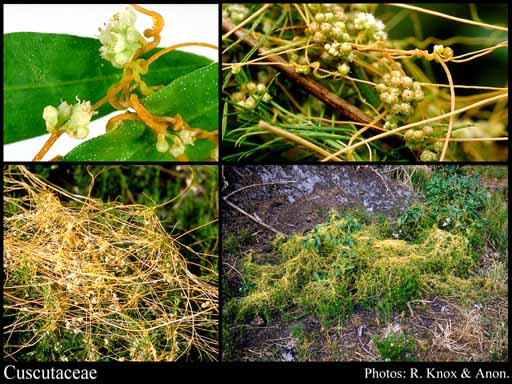This name is not current. Find out more information on related names.
- Reference
- Anal.Fam.Pl. p20, 25 (1829)
- Name Status
- Not Current

Scientific Description
Common name. Dodder Family.
Family Sometimes included in Convolvulaceae.
Habit and leaf form. Parasitic herbaceous climbers. Plants of very peculiar form (with threadlike, chlorophyll-less twining stems and short-lived root systems). Leaves much reduced. Plants rootless (in that the normal root system is ephemeral); totally parasitic. On aerial parts of the host. Plants with neither basal nor terminal concentrations of leaves. Climbing; stem twiners (with haustoria). Leaves minute; alternate; spiral; membranous; sessile; non-sheathing; simple; epulvinate. Leaf blades entire. Leaves without stipules. Stem anatomy. Secondary thickening absent.
Reproductive type, pollination. Fertile flowers hermaphrodite. Unisexual flowers absent. Plants hermaphrodite.
Inflorescence and flower features. Flowers small; regular; (3–)5 merous; cyclic; tetracyclic. Free hypanthium absent. Perianth with distinct calyx and corolla; 6, or 10; 2 -whorled; isomerous. Calyx (3–)5; 1 -whorled; gamosepalous; imbricate. Corolla (3–)5; 1 -whorled; appendiculate (with lobed or fringed scales alternating with the stamens); gamopetalous; valvate; regular; white, or pink. Androecium 5, or 10 (if the scales alternating with the stamens are interpreted as staminodes). Androecial members adnate (to the corolla tube); free of one another; 1 -whorled, or 2 -whorled (i.e. including the scales). Androecium exclusively of fertile stamens, or including staminodes (in the form of lobed or fimbriate scales). Staminodes 5. Stamens 5; isomerous with the perianth; alternisepalous. Anthers dehiscing via longitudinal slits; tetrasporangiate. Gynoecium 2 carpelled. The pistil 2 celled. Gynoecium syncarpous; synovarious, or synstylovarious; superior. Ovary plurilocular; 2 locular. Styles 2; free, or partially joined; apical. Stigmas dry type; papillate; Group II type. Placentation basal. Ovules 2 per locule; ascending; anatropous.
Fruit and seed features. Fruit non-fleshy, or fleshy; dehiscent; a capsule. Capsules splitting irregularly (or opening by a transverse slit). Seeds endospermic. Endosperm oily. Cotyledons 0 (or scarcely recognisable as such). Embryo chlorophyllous (1/4); curved, or coiled. Seedling. Germination type inapplicable in the absence of cotyledons.
Geography, cytology, number of species. World distribution: cosmopolitan. X = 7, 15. 170 species.